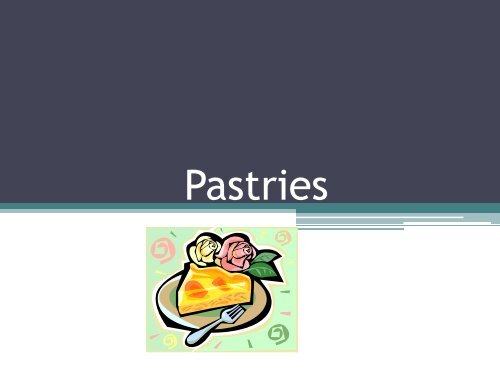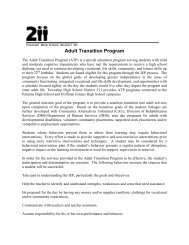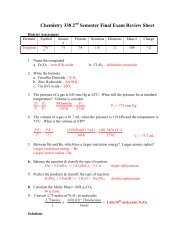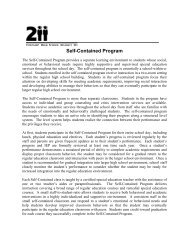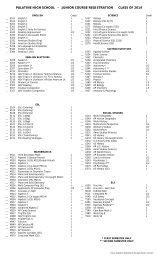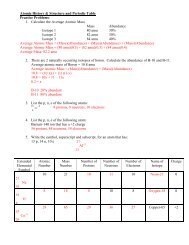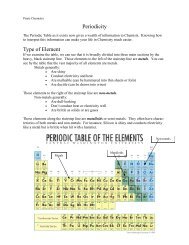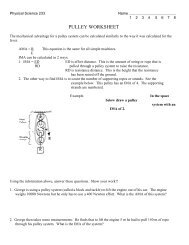Pastries
Pastries
Pastries
You also want an ePaper? Increase the reach of your titles
YUMPU automatically turns print PDFs into web optimized ePapers that Google loves.
<strong>Pastries</strong>
Types of Pastry<br />
• What is pastry?<br />
▫ A large variety of baked crusts made from<br />
doughs rich in fat<br />
• 5 examples of pastry<br />
▫ Cream puffs<br />
▫ Puff pastry<br />
▫ Danish & French pastries<br />
▫ Rich yeast & cake-type sweet rolls<br />
▫ Pies
Ways to Use Pastry…<br />
• Dessert<br />
▫ Fruit Pie<br />
▫ Custard Pie<br />
▫ Tart<br />
• Accompaniment<br />
▫ Pastry cut into strips or<br />
fancy shapes<br />
▫ To garnish salads or soups<br />
• Main Dish<br />
▫ Quiche<br />
▫ Chicken Pot Pie
The Main Types of Pastry…<br />
• 2 main types of pastry<br />
▫ Plain Pastry<br />
• Golden-brown flaky<br />
(blistered) surface<br />
• Tender<br />
• Usually used for pies<br />
▫ Puff Pastry<br />
• Extra rich<br />
• Extra flaky<br />
• Examples: Croissants, Danishes
Nutrients & Storage…<br />
• Nutrients<br />
▫ All pastries contain a high<br />
proportion of fat<br />
▫ Contribute energy &<br />
calories to the diet<br />
• Storage<br />
▫ Store unused chiffon,<br />
custard, & meat pies in the<br />
fridge<br />
▫ Both baked & unbaked<br />
pies can be frozen<br />
• Wrap them in freezer wrap or<br />
put in freezer bags
Ingredients for good pastry…<br />
• All-purpose flour<br />
• A firm “fat”<br />
▫ Usually vegetable shortening or lard<br />
• A small amount of water<br />
▫ 2 Tbsp. for each 1 cup of flour<br />
• Salt
Ingredients for a good pastry…<br />
• Purpose of flour in a recipe?<br />
▫ Gluten of the flour forms the structure of the<br />
pastry
Purpose of fat in a pastry…<br />
• Fat...<br />
▫ Coats the particles of flour<br />
▫ Separates the gluten strands<br />
▫ “Shortens” (makes tender) the pastry<br />
• Too much shortening<br />
▫ Fragile & crumbly pastry<br />
• Too little shortening<br />
▫ Tough pastry
Ingredients for a good pastry…<br />
• Which fats are used to make pastry?<br />
▫ Vegetable shortening or lard<br />
• Why wouldn’t you use butter or margarine?<br />
▫ They produce a less tender pastry<br />
▫ Lard produces the most tender pastry<br />
▫ Oil makes a mealy pastry
Ingredients for good pastry…<br />
• Purpose of water in pastry<br />
▫ Provides moisture needed to develop gluten<br />
• Too much water<br />
▫ Pastry will be tough<br />
• Too little water<br />
▫ Pastry will be dry, crumbly, and difficult to roll
Salt<br />
• Purpose of salt in pastry<br />
▫ Contributes to the flavor of<br />
pastry<br />
▫ Has no influence on flakiness or<br />
tenderness
Convenience <strong>Pastries</strong>…<br />
• 4 forms of convenience pastries<br />
A. Mixes<br />
B. Frozen<br />
• Whole pies<br />
• Pie fillings<br />
C. Canned<br />
• Pie filling & canned fruits<br />
• Custards<br />
D. Ready-to-eat<br />
• You can create homemade pastry mix<br />
▫<br />
▫<br />
▫<br />
Combine the correct proportions of flour, salt,<br />
& shortening<br />
Store in an airtight container<br />
Add water when you are ready to bake a pie
1 st Principle: Gluten Formation<br />
• The gluten in the flour forms a structure in<br />
which entrapped air and moisture expand<br />
during baking, giving a blistered effect that<br />
is characteristic of flaky pastry.<br />
• Too much flour will produce a tough pastry
2 nd Principle: Mixing & Handling<br />
• Temperature of ingredients<br />
▫ Room temperature = more tender pastry<br />
• Overmixing the ingredients causes gluten<br />
to overdevelop & a tough pastry
Rolling out the pastry dough…<br />
• Handle the pastry as little as possible<br />
to avoid toughening it<br />
• 6 steps in rolling pastry:<br />
1. Gather dough into a firm ball<br />
2. Flatten dough ball with palm of hand<br />
3. Roll pastry from the center toward the edge<br />
4. Roll gently until pastry is 1/8 inch thick & 1 inch<br />
larger than pie pan<br />
5. Fold pastry into “fourths”<br />
6. Unfold pastry into pie pan, pressing on the sides &<br />
bottom<br />
• Do not stretch the pastry because it<br />
will cause shrinking during baking
Assemble<br />
• Flute: Pinching the edge of the pastry with your fingertips to<br />
retain filling and create an attractive edge.<br />
• Hook the points of the fluted edges under the pan rim to<br />
minimize shrinking during baking.<br />
• Prick the bottom & sides of the pastry used for a single-shell pie<br />
before baking<br />
▫ Prevents puffing during baking<br />
• Slit the top of a two-crust pie to allow steam to escape during<br />
baking<br />
• Cover the fluted edge with a 1½-inch strip of foil to prevent<br />
overbrowning
3 rd Principle: Baking Pastry<br />
• If only 1 rack is needed to bake a pie, place it in<br />
the center of the oven<br />
• If 2 racks are needed to bake pies<br />
▫ Arrange racks evenly in the oven<br />
▫ Arrange the pans to allow the heat to circulate<br />
• Good pastry<br />
▫ Evenly browned<br />
▫ Blistered surface<br />
▫ Crisp & tender


